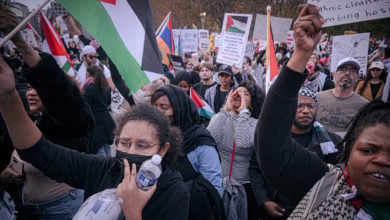Thursday, Jan. 11 marked the fifth anniversary of the first detainee being brought to the U.S. prison in Guantánamo, Cuba. The U.S. government continues to hold approximately 400 men there, almost none of whom have ever been charged with a crime. Human rights organizations have roundly condemned this practice.
Protests demanding “Shut down Guantánamo” took place in Washington, D.C., in other cities and towns across the
|
In Washington, D.C., hundreds gathered at the U.S. Capitol. Many participants wore orange jump suits and hoods to represent the prisoners in Guantánamo. The protesters marched to the Supreme Court and then to the U.S. district court building.
Inside the U.S. district court building, almost 90 demonstrators held signs and wore t-shirts opposing Guantánamo. They were arrested shortly thereafter. When asked their names, many gave the name of a Guantánamo prisoner.
Others demonstrated outside representing Guantánamo prisoners demanded to be let into the courthouse while others chanted “let them in” in support. Police shut down the court’s main entrance, diverting everyone to side entrances. Following the rally outside, people marched to the White House where the day’s event concluded.
Those who participated in Jan. 11 events have vowed to continue the fight to shut down Guantánamo. Astounding revelations about the reality of the prison continue to surface.
Torture
Prisoners at Guantánamo are kept in isolation for the greater part of the day. They are blindfolded when being transferred from one camp to another and are not allowed to talk in groups of more than three.
On May 30, a panel of United Nations human rights officials condemned the torture of Guantánamo detainees and called for closing the military prison. The panel was joined by German chancellor Angela Merkel, Danish prime minister Anders Fogh Rasmussen and Britain’s attorney general Peter Goldsmith.
The U.N. panel denounced the Guantánamo Bay detention camp following an 18-month study in which they reviewed questionnaires and interviews by former detainees and lawyers of current ones. They were denied private interviews with actual detainees.
A report released early in January 2007 included testimony of FBI agents who reported several incidents of abusive treatment and torture at Guantánamo, including extreme heat and cold, beatings and use of dogs to threaten inmates.
Testimony charged that detainees were forced to urinate and defecate on themselves when they were chained to the floor and left for more than 24 hours in interrogation rooms.
Approximately 770 prisoners are estimated to have been confined in Guantánamo over the last five years, held essentially as kidnap victims. Only 10 of the prisoners have ever even been charged with a crime.
The U.N. and some bourgeois politicians in the United States are calling for the closing of Guantánamo Bay’s
|
Secretary of State Condoleezza Rice rejected the United Nations report, explaining that the prison will only be closed in due time. “Absolutely we want to see the day when Guantánamo can close,” she claimed.
But evidence shows that the Pentagon has no intention whatsoever to leave Guantánamo. In June 2005, the Department of Defense announced that defense contractor Halliburton would be building a new $30 million detention facility and security perimeter around the base at Guantánamo Bay.
A vestige of colonialism
The U.S. naval station at Guantánamo Bay, covering 45 square miles, was established in 1898 during the U.S. invasion of Cuba during the Spanish-American War. Ironically, it was Cuba’s first president, Tomás Estrada Palma, a U.S. citizen favoring the outright annexation of Cuba by the United States, who granted perpetual lease of the bay to the U.S. government in 1903.
Today, Guantánamo Bay remains a vestige of colonialism, condemned by the revolutionary government of Cuba and Cuban citizens as “an imperialist infringement of our sovereignty.” The U.S. naval base at Guantánamo Bay is an illegally occupied area.
While an official U.S. military website boasts Guantánamo as “the United States’ oldest overseas naval base,” the Cuban Ministry of Foreign Affairs refers to it as a “U.S. black hole.”
In response to the U.S. Department of Defense human rights report last year, Cuban foreign minister Felipe Pérez Roque said, “Cuba recognizes that there are violations of human rights in our country. But they are at the Guantánamo Naval Base, in territory occupied against Cuba’s will.”
The anti-war ANSWER Coalition (Act Now to Stop War and End Racism) and the Party for Socialism and Liberation supported the Jan. 11 events opposing the U.S. torture camp at Guantánamo. ANSWER volunteers and PSL members in Washington, D.C., Chicago and other cities joined protests and marches that took place.
The demand to “Shut down Guantánamo” will be featured on March 17 as part of the national march on the Pentagon to stop the war on Iraq. March 17 is the weekend preceding the fourth anniversary of the criminal U.S. invasion of Iraq.








